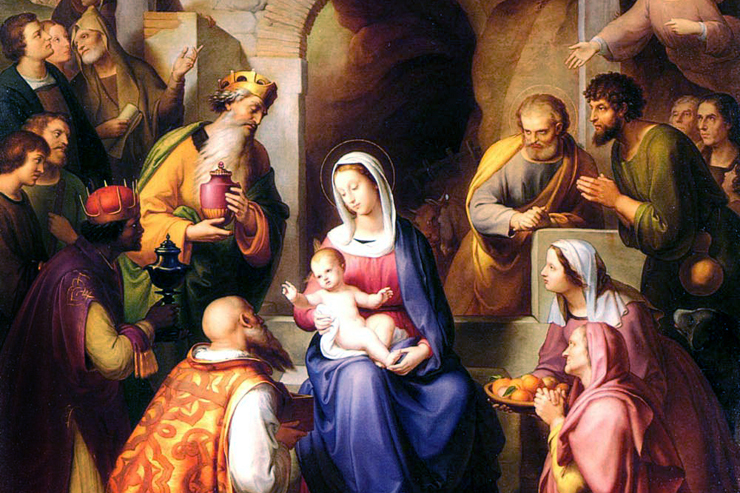
Putting aside that the numbering is not exact, we generally talk about Lent being forty days. Like me, you have probably wondered “why forty?” What’s so special about forty?? The obvious answer is that Our Lord spent forty days fasting in the desert before He began his public ministry. He set apart that time to prepare Himself and as an example for us. So, that’s what we should do.
During this time He was tempted by the devil in three ways. He ate nothing—nothing!!—for forty days! But that wasn’t more than our Savior could handle, of course. Following His example, we enter the desert of Lent for forty days. We fast—well, we give up chocolate, anyway. We take on extra mortification, prayer and alms giving, leaning on His power to overcome the devil’s temptations both during this penitential season and those that traipse behind us all the days of our life.
Jesus then went out!
He spent forty days alone and fasting and then He went out and made public what He was about. He was about redeeming the world from the effect of original sin: spiritual death. And His mission was to make possible a new birth for us. We are made new by inserting ourselves into His mystery. This is a daily conversion—and Lent is our yearly reminder to begin again.
But still, why did He choose forty days for His preparatory retreat?
We can again look farther back, to the Old Testament Israelites. God laid patterns in human history in the story of His chosen people—that we follow in our own lives even today. When Moses led them out of slavery in Egypt, they spent forty years in the desert en route to the promised land.
What the heck were they doing along the way??? It’s not really that far! I checked. I’m not sure where they were coming from exactly, but from Egypt to Jerusalem—not even at the shortest distance—is about 270 miles. I did the math and at a stroll pace of twenty minutes per mile, walking eight hours per day, taking off the whole weekend (even though weekends hadn’t been invented yet), a person could traverse this distance in under two weeks. So, even if they cut the walking time per day in half, prepared gourmet meals each night, stopped at every point of interest to gawk, and painted a giant group selfie with pigments naturally derived from the local desert plants and minerals, they should have been able to pull it off in a year, tops. But forty years??
At the same pace, one could literally circumnavigate the Earth (24,901 miles)—on foot—ten times (assuming bridges or the ability to walk on water)!
What took them so long? It could be that they grew accustomed to doing things a certain way and couldn’t envision arriving somewhere. Maybe they found a comfortable place that they really liked, even though it wasn’t where they were destined to be and was nowhere as good as their destination was for them. Perhaps it seemed like too much trouble to tromp along with their families, belongings, livestock and that heavy ark of the covenant, so they settled for good enough.
None of these reasons would surprise me. They are some of the same reasons we don’t carry on in our journey of sanctification. The history of salvation, from the Garden of Eden, through the people of Israel to the Mystery of Christ, is a pattern the Father has shown us for sin and redemption. What they did, we do.
Or, just maybe there is more hidden in Holy Scripture than theologians can uncover.
Maybe the specialist we need to interpret much of Scripture is a comedian—steeped in Jewish culture and proficient in Hebrew. (I’ve always longed to hear the Bible read by an old Jewish guy from Brooklyn named Lenny.) It’s possible that the journey did not actually take forty years, but only seemed to, what with all the murmuring, grumbling and complaining.
The Israelites said to them, “If only we had died at the Lord’s hand in the land of Egypt, as we sat by our kettles of meat and ate our fill of bread! But you have led us into this wilderness to make this whole assembly die of famine!”
There is a lot of good material for the right kind of humorist here!
But I think it probably did take forty years. Because there is another, more basic template for the number forty that goes back even before God’s chosen people. It goes all the way back to the garden—that first of the gardens where all the important stuff has happened—the Garden of Eden. When Adam and Eve sinned through pride and disobedience the curses that came upon them along with spiritual death were to work to bring forth food and pain in childbirth.
Everything that followed has been an effort to get back into grace with God. He has patiently taught us (often kicking and screaming) to trust Him and has given us the grace to finally do it. Our Savior made the grace available; we must avail ourselves of it. The real promised land is heaven. To enter, we must be re-born in grace through faithful obedience to God’s will. This process of growing in sanctity is a period of gestation for our re-birth as a new creation in Christ.
As Lent is a preparation for celebrating New Life in Christ at Easter, it is also a time when we pray ardently for catechumens, who will be born again in baptism at the Easter Vigil Mass. Our hope for ourselves is also a new start—to become new again.















